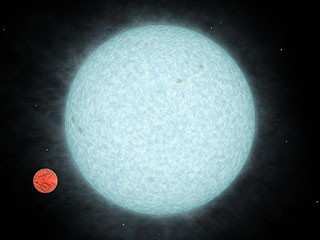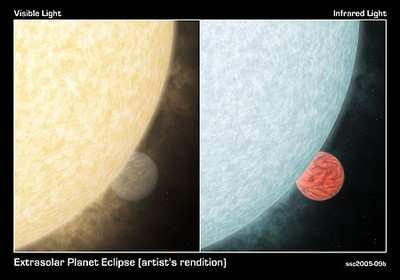First Time They've Actually Been Seen
NASA's Spitzer Space Telescope has for the first time captured
the light from two known planets orbiting stars other than our Sun.
The findings mark the beginning of a new age of planetary science,
in which "extrasolar" planets can be directly measured and
compared.

"Spitzer has provided us with a powerful new tool for learning
about the temperatures, atmospheres and orbits of planets hundreds
of light-years from Earth," said Dr. Drake Deming of NASA's Goddard
Space Flight Center, Greenbelt, Md., lead author of a new study on
one of the planets.
"It's fantastic," said Dr. David Charbonneau of the
Harvard-Smithsonian Center for Astrophysics, Cambridge, Mass., lead
author of a separate study on a different planet. "We've been
hunting for this light for almost 10 years, ever since extrasolar
planets were first discovered." The Deming paper appears today in
Nature's online publication; the Charbonneau paper will be
published in an upcoming issue of the Astrophysical Journal.
So far, all confirmed extrasolar planets, including the two
recently observed by Spitzer, have been discovered indirectly,
mainly by the "wobble" technique and more recently, the "transit"
technique. In the first method, a planet is detected by the
gravitational tug it exerts on its parent star, which makes the
star wobble. In the second, a planet's presence is inferred when it
passes in front of its star, causing the star to dim, or blink.
Both strategies use visible-light telescopes and indirectly reveal
the mass and size of planets, respectively.

In the new studies, Spitzer has directly observed the warm
infrared glows of two previously detected "hot Jupiter" planets,
designated HD 209458b and TrES-1. Hot Jupiters are extrasolar gas
giants that zip closely around their parent stars. From their
toasty orbits, they soak up ample starlight and shine brightly in
infrared wavelengths.
To distinguish this planet glow from that of the fiery hot
stars, the astronomers used a simple trick. First, they used
Spitzer to collect the total infrared light from both the stars and
planets. Then, when the planets dipped behind the stars as part of
their regular orbit, the astronomers measured the infrared light
coming from just the stars. This pinpointed exactly how much
infrared light belonged to the planets. "In visible light, the
glare of the star completely overwhelms the glimmer of light
reflected by the planet," said Charbonneau. "In infrared, the
star-planet contrast is more favorable because the planet emits its
own light."
The Spitzer data told the astronomers that both planets are at
least a steaming 1,000 Kelvin (727 degrees Celsius, 1340
Fahrenheit). These measurements confirm that hot Jupiters are
indeed hot. Upcoming Spitzer observations using a range of infrared
wavelengths are expected to provide more information about the
planets' winds and atmospheric compositions.
The findings also reawaken a mystery that some astronomers had
laid to rest. Planet HD 209458b is unusually puffy, or large
for its mass, which some scientists thought was the result of an
unseen planet's gravitational pull. If this theory had been
correct, HD 209458b would have a non-circular orbit. Spitzer
discovered that the planet does in fact follow a circular path.
"We're back to square one," said Dr. Sara Seager, Carnegie
Institution of Washington, co-author of the Deming
paper. "For us theorists, that's fun."

Spitzer is ideally suited for studying extrasolar planets known
to transit, or cross, stars the size of our Sun out to distances of
500 light-years. Of the seven known transiting planets, only the
two mentioned here meet those criteria. As more are discovered,
Spitzer will be able to collect their light – a bonus for the
observatory, considering it was not originally designed to see
extrasolar planets. NASA's future Terrestrial Planet Finder
coronagraph, set to launch in 2016, will be able to directly image
extrasolar planets as small as Earth.
Shortly after its discovery in 1999, HD 209458b became the first
planet detected via the transit method. That result came from
two teams, one led by Charbonneau. TrES-1 was found via the transit
method in 2004 as part of the NASA-funded Trans-Atlantic Exoplanet
Survey, a ground-based telescope program established in part by
Charbonneau.
 Bolen Gives Congress a Rare Thumbs-Up
Bolen Gives Congress a Rare Thumbs-Up The SportPlane Resource Guide RETURNS!!!!
The SportPlane Resource Guide RETURNS!!!! Buying Sprees Continue: Textron eAviation Takes On Amazilia Aerospace
Buying Sprees Continue: Textron eAviation Takes On Amazilia Aerospace Hawker 4000 Bizjets Gain Nav System, Data Link STC
Hawker 4000 Bizjets Gain Nav System, Data Link STC Echodyne Gets BVLOS Waiver for AiRanger Aircraft
Echodyne Gets BVLOS Waiver for AiRanger Aircraft





